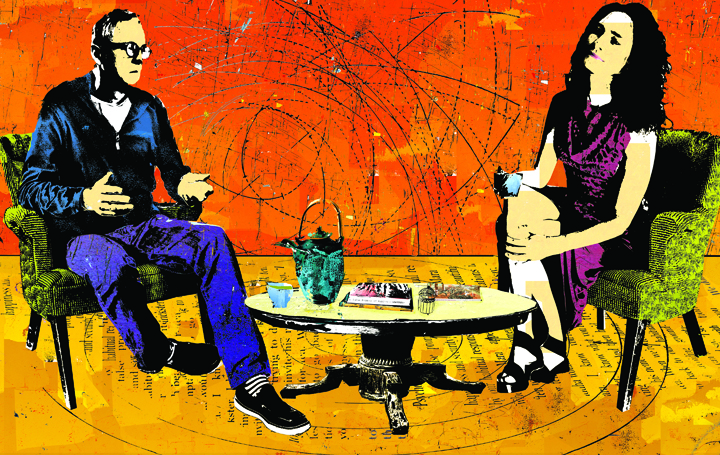 Tea with Mara
There are various versions of this story. This is my summary of the lengthy myth:
Just prior to enlightenment, the Buddha was approached by Mara, the Demon God, along with his daughters and an army representing craving, boredom, passion, anger, and pride. The story goes that Mara tempted and challenged the Buddha to leave his enlightened state and re-enter the world of the mind and ego, but the Buddha did not give in and Mara and his army went away. But not for good.
In the future when Mara would show up with his enticements, the Buddha would invite him in to have tea. Mara would stay a while and then leave, and the Buddha would be left undisturbed.
Joseph Goldstein and Jack Kornfield write, in Seeking the Heart of Wisdom, that we are challenged by hindrances again and again in the course of our lives, and so it is important to learn to work with them when they show up. Pema Chodron writes, “Mara represents the false promise of happiness and security offered by our habitual responses.” However If we are willing to sit what he brings, without fighting, suppressing or ignoring the feelings, we can strengthen, clarify and deepen our awareness and understanding of ourselves and be freed from old patterns and habits.
In my piece, Tea with Mara, I have set the myth in contemporary times and left it up to the viewer to decide who is the Buddha and who is Mara. In the myth, both are male, but they are meant to represent everyone.
For the creation of this piece, I had people pose in multiple positions and I chose the positions that worked best. The lines in the background are from a vintage astronomy chart, and the words underfoot are from different texts which tell the story of Mara and the Buddha. Between them on the floor is a vintage astronomy chart of a black hole. Two of the books of the table are my creation (Tea with Mara and False Promise of Happiness; the third is Jung’s Man and His Symbols. The “cover” of Jung’s book is a war scene from a vintage Spanish WWI card. As always, the color and texture from the piece comes from photos that I have taken of weathered paint, paper, rust and other colors and textures I have photographed. The cage on the table, which I found at an antique shop, represents the psychological confinement we suffer unless we become aware of our tendencies, habits and self-made traps.
Tea with Mara
There are various versions of this story. This is my summary of the lengthy myth:
Just prior to enlightenment, the Buddha was approached by Mara, the Demon God, along with his daughters and an army representing craving, boredom, passion, anger, and pride. The story goes that Mara tempted and challenged the Buddha to leave his enlightened state and re-enter the world of the mind and ego, but the Buddha did not give in and Mara and his army went away. But not for good.
In the future when Mara would show up with his enticements, the Buddha would invite him in to have tea. Mara would stay a while and then leave, and the Buddha would be left undisturbed.
Joseph Goldstein and Jack Kornfield write, in Seeking the Heart of Wisdom, that we are challenged by hindrances again and again in the course of our lives, and so it is important to learn to work with them when they show up. Pema Chodron writes, “Mara represents the false promise of happiness and security offered by our habitual responses.” However If we are willing to sit what he brings, without fighting, suppressing or ignoring the feelings, we can strengthen, clarify and deepen our awareness and understanding of ourselves and be freed from old patterns and habits.
In my piece, Tea with Mara, I have set the myth in contemporary times and left it up to the viewer to decide who is the Buddha and who is Mara. In the myth, both are male, but they are meant to represent everyone.
For the creation of this piece, I had people pose in multiple positions and I chose the positions that worked best. The lines in the background are from a vintage astronomy chart, and the words underfoot are from different texts which tell the story of Mara and the Buddha. Between them on the floor is a vintage astronomy chart of a black hole. Two of the books of the table are my creation (Tea with Mara and False Promise of Happiness; the third is Jung’s Man and His Symbols. The “cover” of Jung’s book is a war scene from a vintage Spanish WWI card. As always, the color and texture from the piece comes from photos that I have taken of weathered paint, paper, rust and other colors and textures I have photographed. The cage on the table, which I found at an antique shop, represents the psychological confinement we suffer unless we become aware of our tendencies, habits and self-made traps.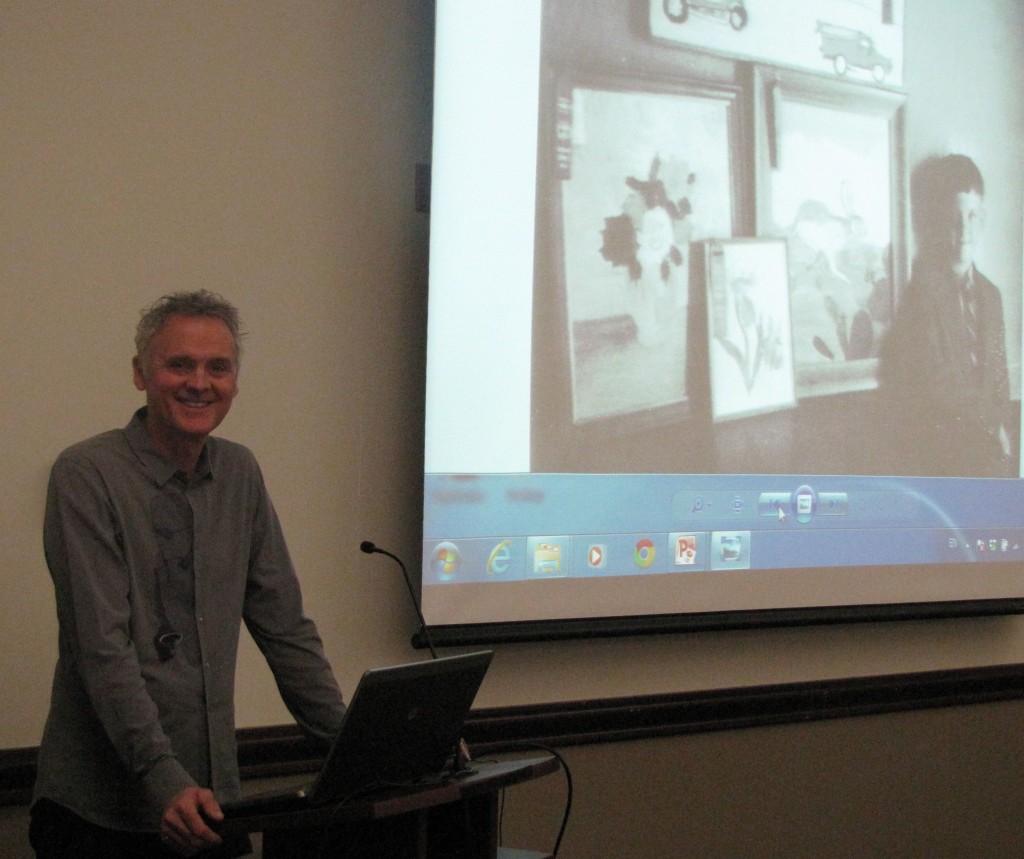
Thanks to the JCC for the invitation to speak about my art and career. Behind me is a projected photo of me at 9 years old taken at the Milan Mirror Newspaper in Milan, Tennessee for winning awards at the Gibson County Fair. The talk covered my early background, mental health training and my art career.
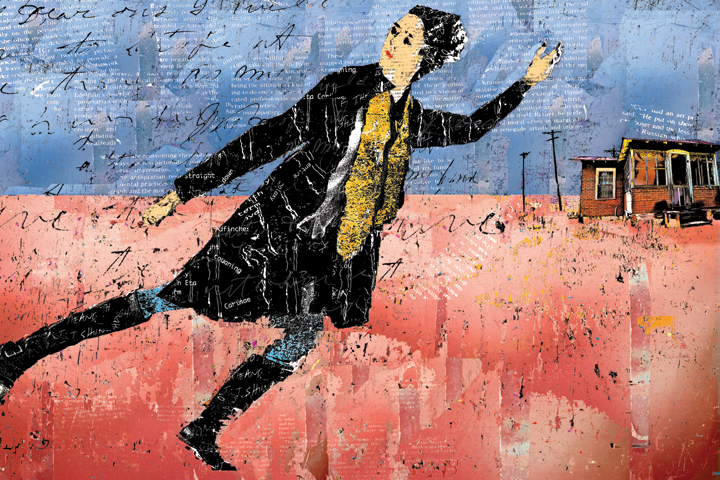
A few years ago I accompanied my wife to The Gathering, a literary event at Keystone College in Pennsylvania. It was there that I learned the story of the poet Ruth Stone and how as a young woman she found inspiration.
I have since learned that Elizabeth Gilbert has made this story famous in one of her TED talks (link). I am not surprised that it has become famous, at least in some circles. I heard it several years ago and have loved it ever since. Below is a transcribed version
“As [Stone] was growing up in rural Virginia, she would be out, working in the fields and she would feel and hear a poem coming at her from over the landscape. It was like a thunderous train of air and it would come barrelling down at her over the landscape. And when she felt it coming…cause it would shake the earth under her feet, she knew she had only one thing to do at that point. That was to, in her words, run like hell to the house as she would be chased by this poem. The whole deal was that she had to get to a piece of paper fast enough so that when it thundered through her, she could collect it and grab it on the page. Other times she wouldn’t be fast enough, so she would be running and running, and she wouldn’t get to the house, and the poem would barrel through her and she would miss it, and it would continue on across the landscape looking for ‘another poet’. And then there were these times, there were moments where she would almost miss it. She is running to the house and is looking for the paper and the poem passes through her. She grabs a pencil just as it’s going through her and she would reach out with her other hand and she would catch it. She would catch the poem by its tail and she would pull it backwards into her body as she was transcribing on the page. In those instances, the poem would come up on the page perfect and intact, but backwards, from the last word to the first.“
About the piece. It was harder than I had imagined to capture this story. I felt a little like I was in a version of MS Stone’s story, running with everything I had and catching the wrong angle, the wrong color, the wrong way to make the words visual, but still catching enough of it that I held on.
In order to create this piece, I used someone I know to act as though she was running while I photographed her. I used multiple photos of weathered paint and paper from urban poster walls, sidewalks and the sides of trains for the color and texture. I photographed the house in rural Lousiana just south of New Orleans and the utility poles between Iowa and Denver. The words come from a vintage letter that I found in an antique shop and a print out of one of Ms Stone’s poems. Link to Ruth Stone Poetry
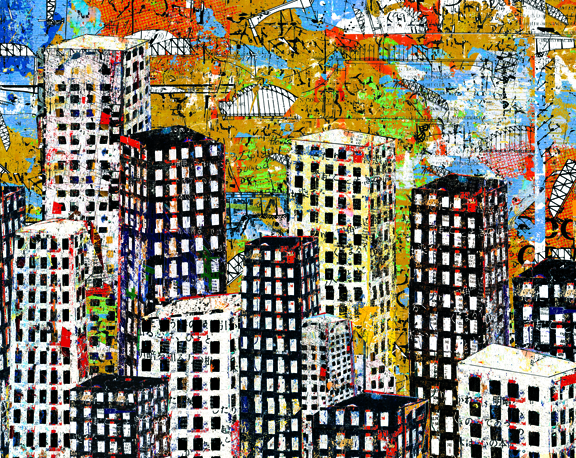
Thanks to Metro Development in Tampa, Florida for their purchase of several of my pieces. I am excited to be a part of their new beautifully remodeled space. Thanks to John Ryan, Chief Executive Officer and Alison West Brown, Artist Agent.
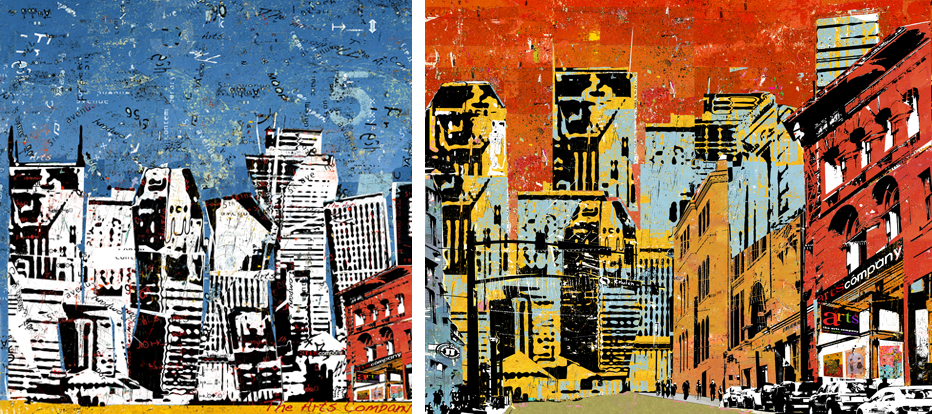
My latest commission is for the Arts Compnay in Nashville. Anne Brown, the owner of the AC asked if I would do something that had downtown Nashville, the AC and is urban and contemporary. I wanted to do two different versions, one more abstract than the other.
This piece has multiple photos that I have taken of the AC, multiple buildings in the downtown area from different angles and multiple photos of weathered paint. The art in the window of the Arts Company is by Denise Stewart-Sanabria, Tres Taylor and Daryl Thetford. http://www.stewart-sanabria.com/ http://www.trestaylor.com/trestaylor/home.html and https://darylthetford.com/ http://www.theartscompany.com/

The cowboy has been portrayed in American culture as a masculine ideal and a symbol of individualism for decades. John Wayne, the Marlboro Man and Clint Eastwood embodied and helped to solidify the cowboy-as-rugged-individualist icon.
Like many men of his generation, my father fully internalized the cowboy image. He lived in south Texas during his early adulthood, at which time he became a literal manifestation of it, trading regular shoes for cowboy boots, and a cap for a cowboy hat. Later, because he wanted a cowboy son to complete the picture, he dressed me in full cowboy regalia. But my preferences leaned toward painting pictures more than riding horses, and, to my father’s disappointment, my cowboy childhood came to an end fairly early. For years, I would try to distance myself not only from all things cowboy, but from all things southern and country; in short, I rejected that which most clearly defined my father, and that which my father so heartily embraced.
But the unconscious has a sense of humor, unexpectedly slipping that which we thought we’d cast off back into the spotlight of our psyche when we aren’t looking. Knowing this, it should not have surprised me when I started to create my western series. And yet it did. The series began when I found a 1906 stereograph cowboy image while on my travels through Omaha. Back home in my studio, I enjoyed retrofitting the cowboy in (very un-cowboylike) clothes and colors, until he emerged as something more interesting, quirky and colorful than his iconic self had been. I was hooked. I began looking for other vintage western images to recreate, and before long I had a reworked pop-art bull rider, which I created using cut up articles from Art News and Art Forum, a cowboy wearing Prada sunglasses, and my “Wu Wei” cowboy, a riff on the Asian concept of “flow.”
But the series raised some serious questions for me. How was it that our culture’s metaphorical cowboy, and the attendant notion of the independent, self-made individualist who needs no one, wound up creating cracks in the very culture it purported to strengthen? While the cowboy (i.e. ideal man) as self-sufficient individualist is an appealing idea, it is one that inevitably causes more anxiety than comfort, more feelings of isolation than community, more puzzlement and feelings of failure when we are forced to admit—as we always are—that we need other people to survive. And another question: how can I pay homage to American culture, and my personal history, while simultaneously attempting to demystify it?
Perhaps the answer lies in recognizing and honoring the cowboy mythology as a part of history whose contribution has been both heroic and tragic. Perhaps it is to see history’s true rugged individualists exactly as they were: not as heroes or mythological figures, but as fallible human beings capable of mistakes and as dependent on one another as we are today. Perhaps if we as a society were to reclaim the “real west” of today—that is, a world that is ethnically diverse, dependent on one another, and very much human, we could, in the process, reclaim the part of ourselves that feels the isolation and pain or those long-ago internalized myths, and set the record straight.
It is always tempting to me, in examining both the personal and the universal influences on my work, to bring my ideas to resolution. If I resist this urge, however, what I come to is something more global and at the same time hopefully more personal to others: the recognition that our images of the west have much to tell us about how we live—but only if we will see them as symbols of our culture’s projections, rather than as a literal group of people whose lifestyle we shallowly long to embrace.
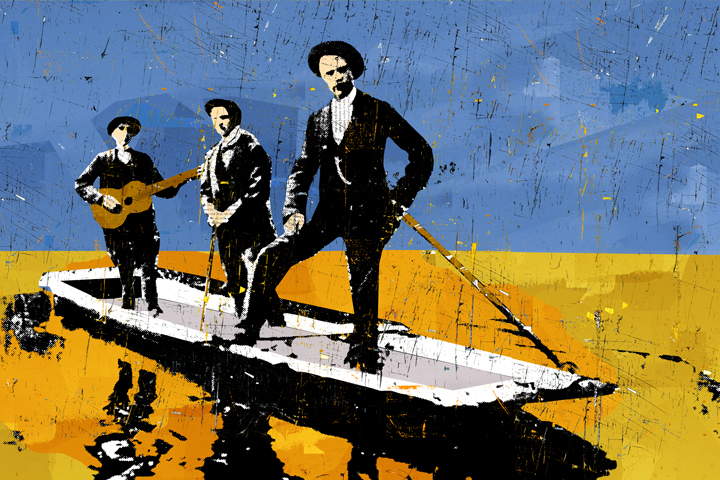
The yet untitled first piece of the year. I am reserving the right to add words to the image, but I like it the way it is too. I will be at the Temple Beth-el show in St Petersburg, Flordia Jan 31-Feb 2.
 For those who have seen Trying Not to Try or have read about it previously on my blog, you know that the image is based on the game, Mind Ball, which is a game of competitive relaxation. This photo of the actual game was taken in Denver, July 4th weekend, 2014. Thanks to all of the 11 year- olds who waited while we took over the game.
For those who have seen Trying Not to Try or have read about it previously on my blog, you know that the image is based on the game, Mind Ball, which is a game of competitive relaxation. This photo of the actual game was taken in Denver, July 4th weekend, 2014. Thanks to all of the 11 year- olds who waited while we took over the game.
Two footnotes: First, I did not look at the game up prior to building my piece since I did not want it to influence my image. Second, the game normally lasts 1-5 minutes, but this one was over in 10 seconds in a meditative blowout. I did not win.
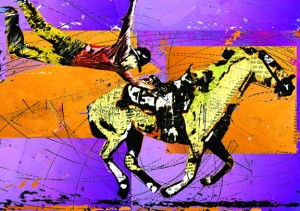
 I am late publishing it, but thank you to the Knoxville Museum of Art which featured my piece, Cityscape with Bridges, 43″ x 54″ , inkjet on aluminum, edition of 9 on the cover of their catalogue and in the live auction on Sept. 14th.
I am late publishing it, but thank you to the Knoxville Museum of Art which featured my piece, Cityscape with Bridges, 43″ x 54″ , inkjet on aluminum, edition of 9 on the cover of their catalogue and in the live auction on Sept. 14th.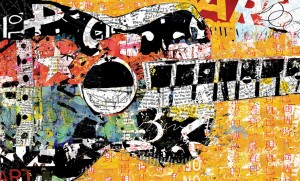
40″ x 66″, inkjet, edition of 1
Thanks to Mary Morris of Mary Morris Arts Management for her recent placement of this commission for Scripps Networks.

Following the successful show at The Arts Company on 5th Avenue in Nashville, the CMHF is continuing the show “The World of Daryl Thetford”. The show, which is in cooperation with The Arts Company, will run from September 12th, 2014 through December 31st, 2014. For additional information or
To purchase or inquire about availability of the artwork please contact
The Arts Company at 615-254-2040 or at www.theartscompany.com
Read more: The Arts Company Presents: Introducing the World of Daryl Thetford
Follow us: @countrymusichof on Twitter | countrymusichof on Facebook
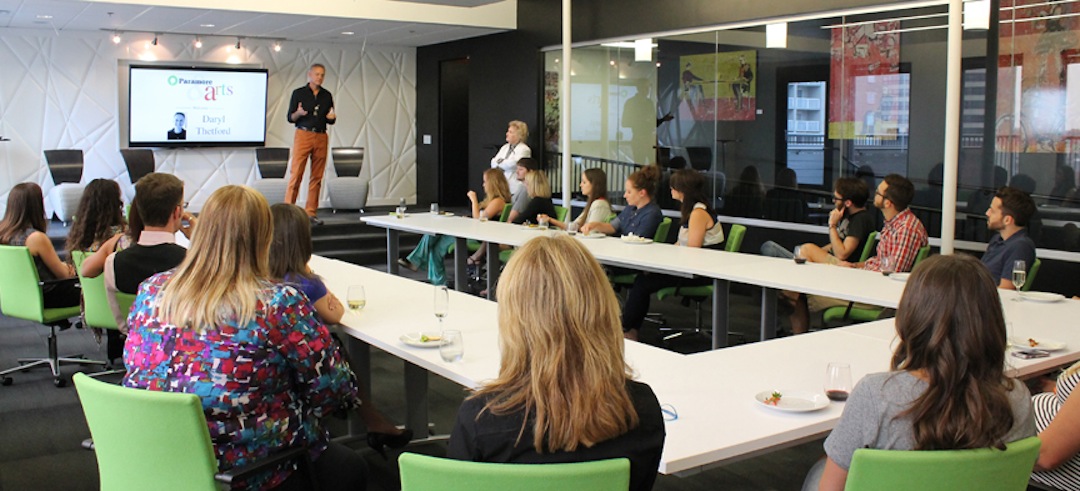

Friday, July 11, 2014 at Paramore Digital, downtown Nashville, Tennessee. Top: speaking at Paramore, bottom left to right, work in Paramore facing conference room, speaking in conference room and Anne Brown, owner of the Arts Company, Daryl Thetford and Hannah Paramore
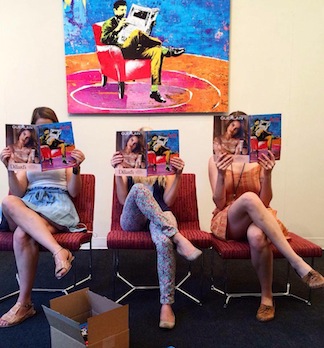

 I realized earlier today that I have not posted anything on my blog about my show at the Arts Company on 5th Avenue in downtown Nashville and it is closing on August 8th, 2014. So if you have not seen it, there is still time.
I realized earlier today that I have not posted anything on my blog about my show at the Arts Company on 5th Avenue in downtown Nashville and it is closing on August 8th, 2014. So if you have not seen it, there is still time.
Below is the information on the show which opened on July 5th, 2014 and was followed by a live discussion between me and Paul Polycarpou, editor of the Nashville Arts Magazine on July 11th, 2014. Paul chose my piece, “Man in Chair : World as a Mandala” for the cover of this months magazine. Paul is the one entertaining the crowd and holding a copy of the magazine in the photo to the right.
INTRODUCING THE WORLD OF DARYL THETFORD at The Arts Company, 5th Avenue, Nahsville, Tennessee
Daryl Thetford offers fresh perspectives to The Arts Company. He uses thousands of images he has captured from urban places such as crumbling walls, grafitti, signs, etc. He uses a collection of these images as an urban background for all of his finished pieces. His images come together through his layering of his own images. He creates narratives based on classical themes that are given new life in our urban culture. The resulting photographs are printed on aluminum in small editions and coated by his hand three times to protect and brighten the surfaces, again to reflect the effect of urban life as we know it. His finished photographs come across as narratives that are embedded in the images.
ABOUT THE ARTIST:
Daryl Thetford grew up on a hundred-acre farm in Bradford, Tennessee, a small town in the rural northwest corner of the state. His father was a forklift operator who worked in a warehouse, and his mother was a beautician. While they encouraged their son to pursue so-called “practical” avenues of work, they also recognized an early artistic bent, and enrolled him in oil painting lessons–which he loved–at age nine. Although he went on to obtain a graduate degree in counseling from Murray State University, and spent 15 years working as a vocational program director, mental health center manager, and a therapist, his creative juices never dried up. In 2001, when Thetford left mental health to return to his first love, art, he discovered that the psychology of behavior and emotion–everything he’d been studying and practicing for years–flowed neatly into his artistic process. The result is a compelling body of photo collage work that is informed by the richness of the psyche
Daryl’s work has been described as graphic, modern, pop, and contemporary, although what to actually call the process has been a larger source of debate; it has been called photo collage, digital art, and digital mixed media. The process begins with Thetford selecting a single, original photographic image followed by a digital layering and combining of dozens of additional original photographs. It is a process, which takes an average of 40 hours. His resulting images range from culturally familiar individual pieces (bikes, cowboys, guitars, cityscapes) to more esoteric series’ based on man’s inner struggle with modern society or the human sense of isolation in the noise of the modern world.
Thetford’s recent exhibits include a solo show at the Art Museum at the University of Memphis; an invitation-only group show at the Annenberg Space in Los Angeles; a solo show at the Jung Center in Houston, Texas; and an upcoming show at the Coffman Gallery at the University of Minnesota. His work has also been shown at SOFA Contemporary, Art Dallas, Art Chicago, the Knoxville Museum of Art, Mobile Museum of Art and others, and is in a number of individual and corporate collections across the nation.
Daryl currently lives with his wife, writer and artist Dana Shavin in Chattanooga, Tennessee. They enjoy travel, great food, great art, and the company of good friends.

I have been asked a number of times recently to describe Man with Cello and the meaning behind the image.
I began with the idea of a man playing a cello. The image would be vertical and primarily just him. Once I created it, however, I was not excited about it and turned it into a horizontal image to allow for more negative space. I found it too simple with too much open space for my taste, so I added the woman, which I built from two mannequins and a vintage hosiery ad.
I normally have an idea of both the concept and image when I begin. In this case, however, once I left the idea of a man alone playing cello, nothing flowed into place. With this void, I struggled more than I do with most of my pieces. I finally had to just leave it alone for a few weeks. When I came back to it I added the music and had a visual flash of them on the shore of a body of water. Again I was stumped and left it for a few weeks. When I came back to it fresh it was apparent that it is a dialogue. The dialogue is between two people, and it is also the dialogue within each of them and with their environment.
This is reflected in the music, the push and pull of the No, No, No and the large YES, the rules in black and white, the softer cursive writing that is not quite clear, and, of course, two of the representatives of external communication, phone and TV.
The writing in the bottom of the piece is a quote by English novelist Iris Murdoch which says that when you begin to acknowledge that people exist outside yourself (as real living beings, not as objects in your world) you are taking the first step away from narcissism.
The Chinese and English on the woman’s flesh is from a book titled Five Fold Happiness. Since I have used bits and fragments, it is nonsensical, and is meant to be representative of luck, prosperity, longevity, happiness and wealth.
Now the dialogue is between the viewer and the piece.
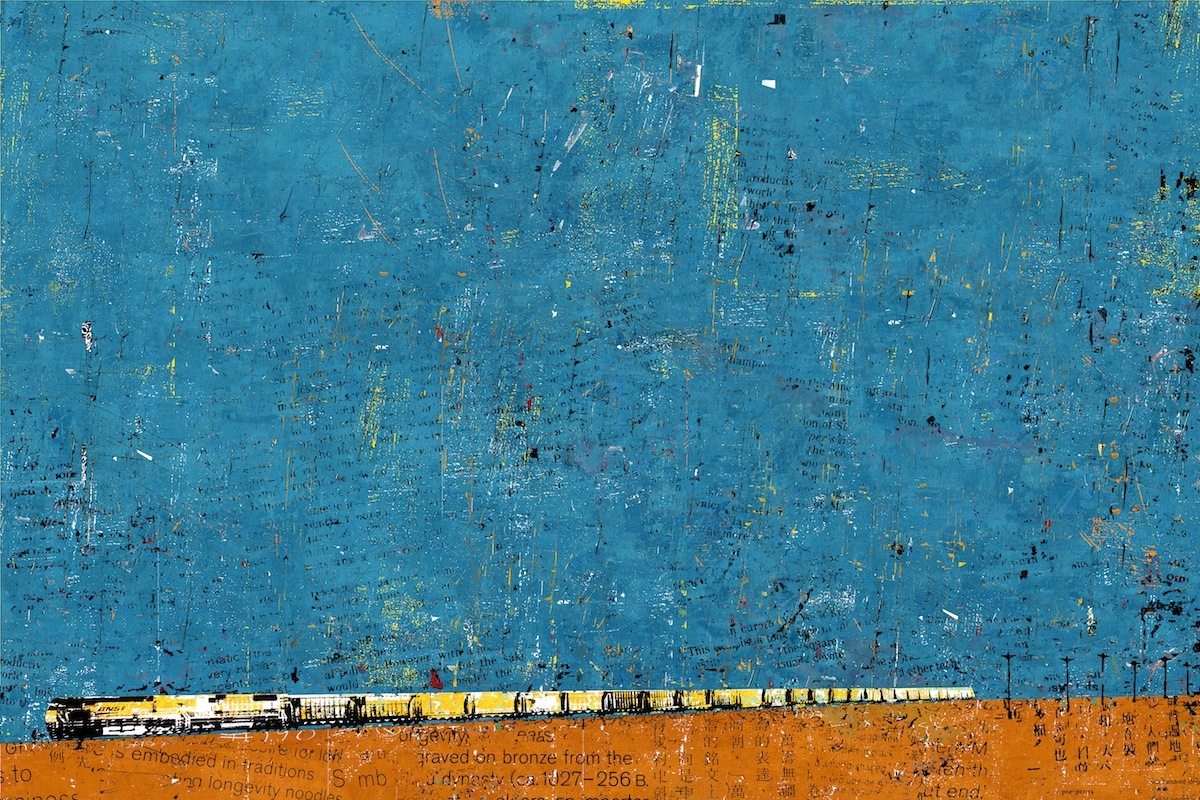
I walk in fields in my mind. Years ago I realized that I was doing this mainly during conversations. I’m not dissociative; to the contrary, often I imagine I am walking with the person I’m talking to. The fields are near my hometown in west Tennessee. Interestingly, while I’ve driven past them many times, I’ve never actually walked in them.
I believe that we make art as a result of a psychological call or need. Since I have most often found inspiration in the color, movement and energy of urban environments, I was initially surprised by my own move in the direction of landscapes. I soon realized, however, that whether I was taking in the vastness of the Great Plains, the majesty of the Rockies, or the simple beauty of the hills and gorges of the Southeast, landscapes provided a template onto which I both projected, and had reflected back to me, my thoughts and emotions. Storms, depending upon my mood, could be dark and threatening or a peaceful isolated shower. A path through a forest could be lonely or lovely.
It’s my goal, in creating landscape images, to provide the viewer with a template onto which thoughts, feelings, and emotions might be projected–to provide a field, so to speak, that invites a larger conversation
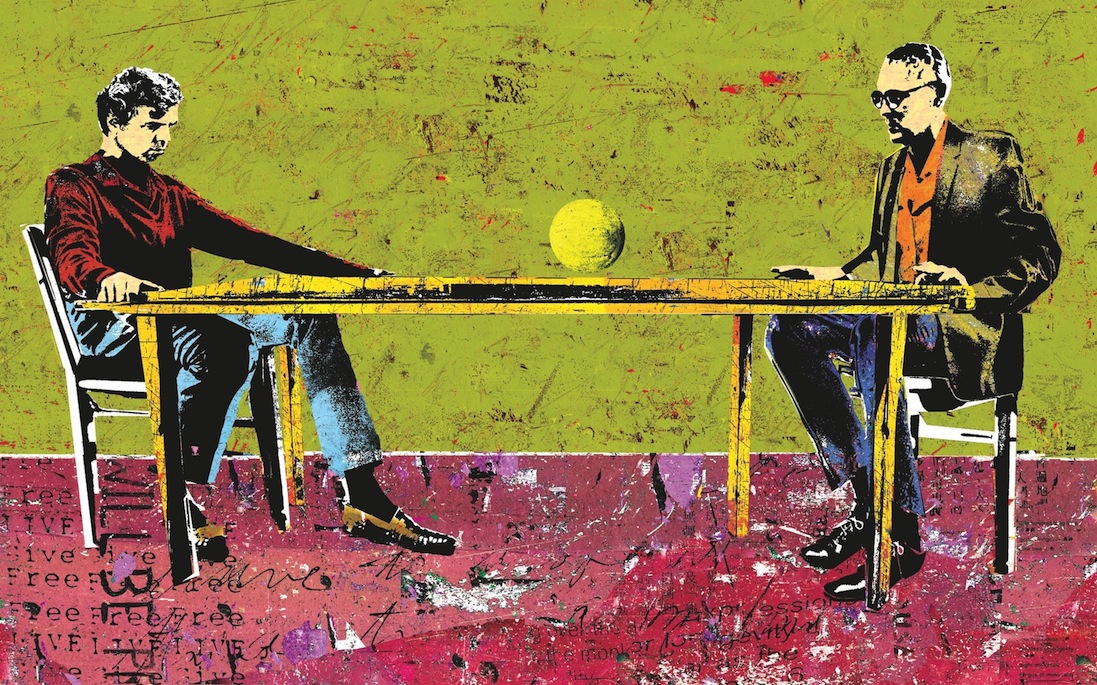
Recently I have been “trying not to try.” I have to say that I don’t love holding opposing concepts in my mind. While I understand the idea intellectually, I have always functioned by choosing between opposites and living the chosen one. But my therapist assures me that choosing to live in the opposites creates the tension that allows broader decisions to be made.
A couple of weeks ago while in New Orleans I was reading about a book called Trying Not to Try, by Edward Slingerland. In the opening of the book, a game called “Mind Ball” is introduced: two participants are seated at opposite ends of a table with a ball between them. The point of the game is to get the ball to the opponent’s end of the table using only brain waves. To this end, electrodes which measure radiate alpha and theta waves (these indicate deep relaxation) are connected to the players’ heads. It is a paradoxical contest of effortful effortlessness, whereby the more relaxed the players can make themselves, the faster they are able to send the ball to their opponent’s side of the table.
After fighting my work process all winter, whereby I set up too many things to do without enough time to do them, the concept of “trying not to try”–of effortless effort–spoke to me. It gave me hope that it’s possible to achieve both relaxed concentration AND productivity–and that I might, as a result, find myself both industrious AND sane. Who would have guessed? Maybe the Voodoo Priestess I met in New Orleans, but that’s a story for another blog post.
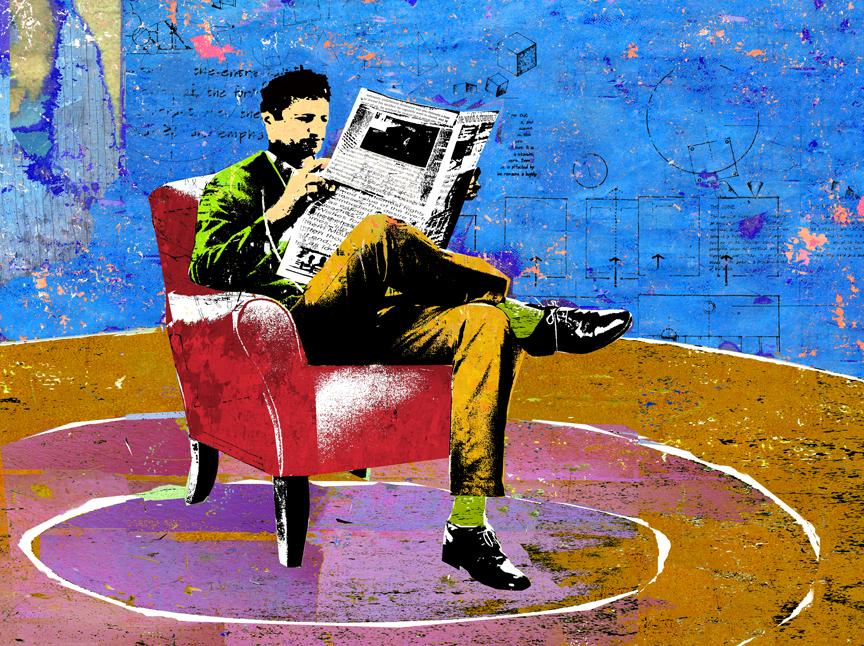
Last year I went on a trip out west with a good friend. I went into the trip knowing that we have very different ways of interacting with the world. When traveling, I am rigidly on time, often arriving at scheduled events long before they begin. I schedule my 3 ½ star hotel rooms well in advance and choose my meals carefully.
My friend, on the other hand, has a more casual relationship with time and destinations. He often leaves hours later than he planned, makes multiple unscheduled stops and drives well into the night. It is not lost on either of us that he is the happier person.
Since I know our style differences, I also realized that a two week trip could create great stress for our friendship. So I vowed that I was going to say YES to everything with a couple of very modest exceptions: I would not drive after midnight, and we would have to arrive at shows on time. At some point during the trip he suddenly turned to me and said “ You are agreeing to everything”. I am, I said, “ I am calling it my YES Tour. “ I told him that it would be interesting to see how this little bit of letting go impacted me.
With his discovery of my experiment, things quickly got interesting. We took an unscheduled site seeing trip into the mountains with someone we did not know, told the chef at an amazing restaurant to bring anything he wanted to bring, and made arrangements to stay on a houseboat instead of a hotel.
This was life changing. I did not know how much it changed me until I began winter in my usual way with stacks of books to read, multiple ideas for series and a 1000 art and exhibit opportunities to apply to. I made the same choice I usually make: do it all instead of to prioritizing based on the reality of time and energy. This is an old pattern passed down for generations in my family which has created various results including never missing work, a perfectly manicured yard, premature aging, needless suffering and multiple levels of neurosis.
I was shocked to realize that, unlike in the past, I was unable to complete everything that I had laid out for the winter. Not only did I not get everything done, I did not even get close. As a result of the Yes Tour, some part of me had decided that letting go was a strategy that made sense.
I am guessing now that my unconscious had a plan all along. It was a setup to overthrow the internal dictator that often over schedules my life. Life was not just one big Yes after the Yes Tour however. Although my new system was in agreement with the Yes that chose to go with the flow of life, it balked at the Yes that agreed to do everything on every list.
This was scary since I have always functioned by over-controlling. So I began to ask myself just how, if I am to work with this new system, can I remain productive without being compulsive.
More on this and the “Wu Wei” tour planned for summer.
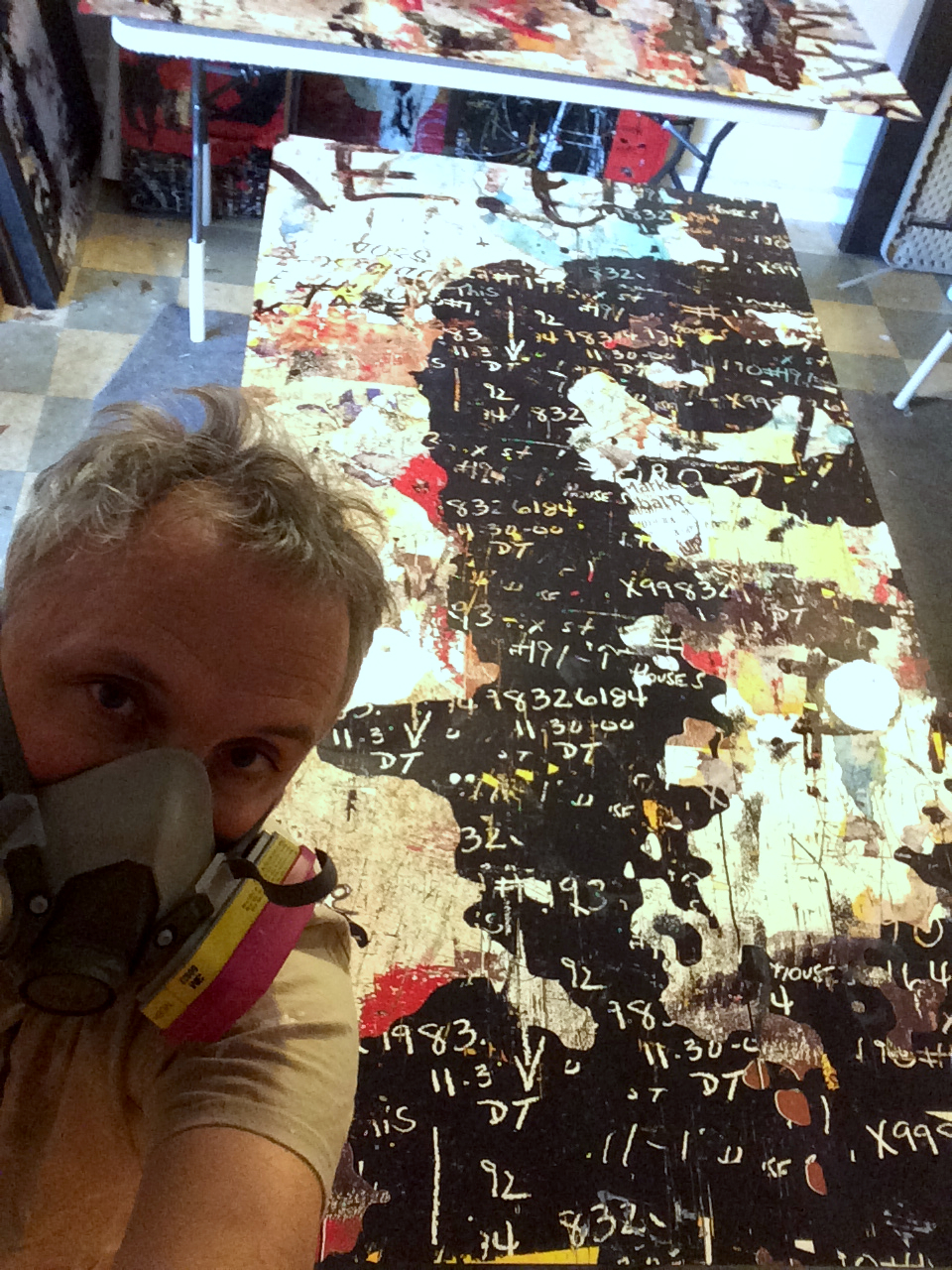

While the image Wake Up is not new, this is the first and only one that is 84″ x 74″. I deliver it today in Tampa.
The two somewhat crude images are a “selfie” of me in the studio coating it and one of the final diptych leaning against my garage for size perspective.
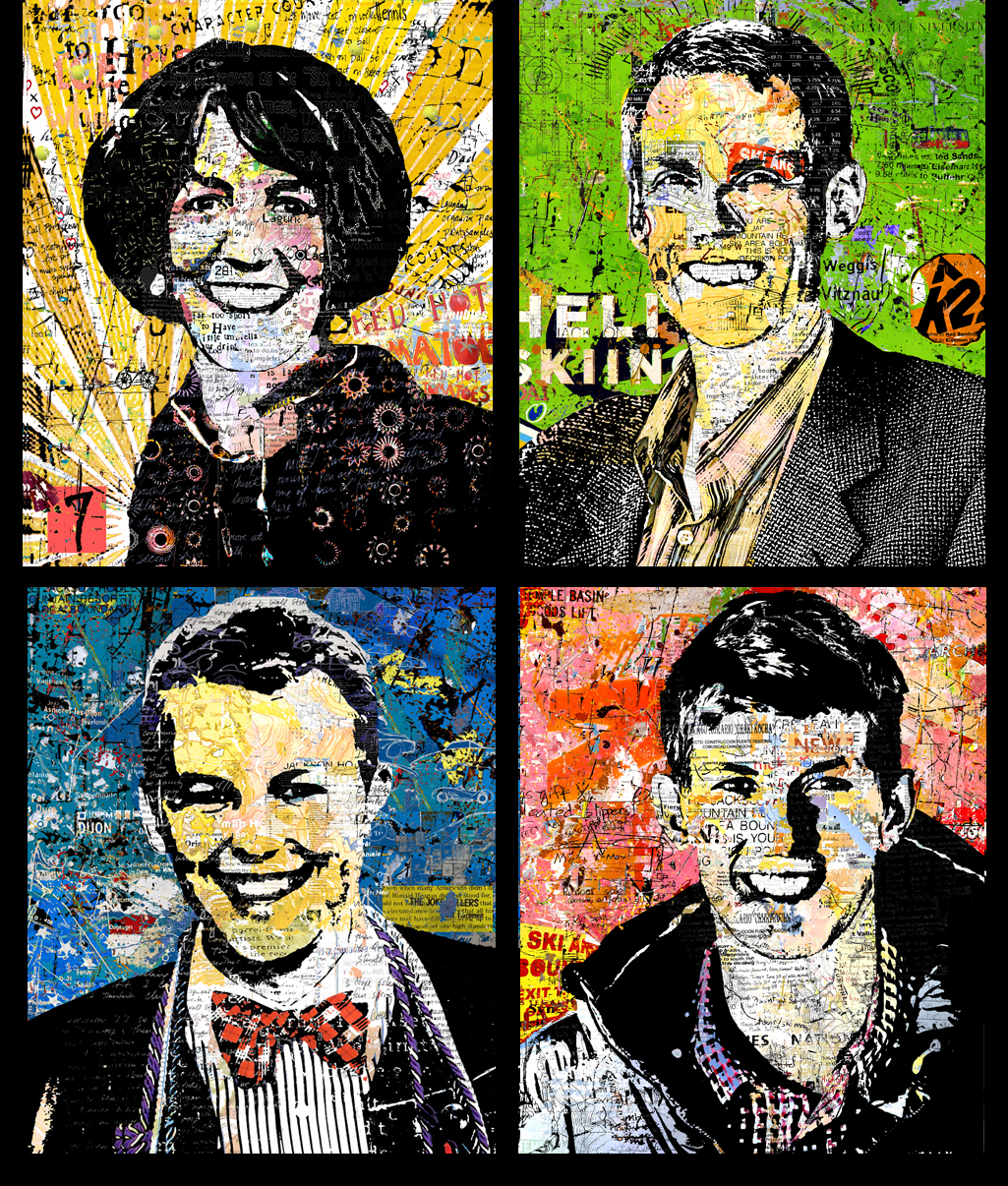
This commission consists of 4 separate pieces. Each piece consists of documents, maps, names of places they have worked and other information that is personal and important to each of them. It is seldom that I do a personal commission, but I am pleased with the way these turned out.
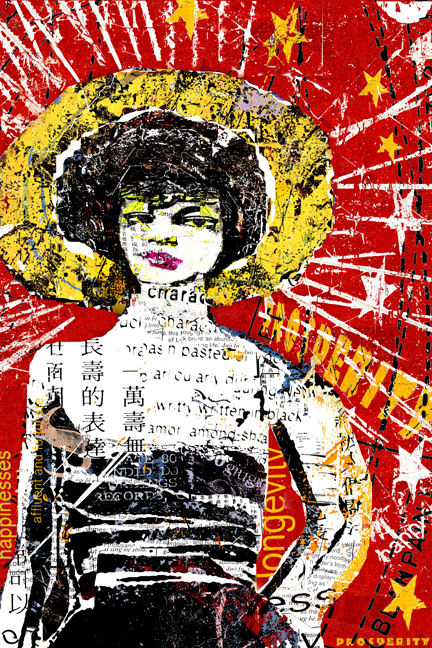
Woman w a Halo : A Modern Icon.
This piece is 36″ x 54″, inkjet on aluminum, edition of 9, completed March, 2014.
I mentioned previously that I am frequently asked two questions.The first question (and answer) was included with my post, “Two New Pieces and Two Frequently Asked Questions.” This is the answer to question #2 (which is really a statement): ”You must have a lot of fun doing these.”
It’s true, I do have fun. Especially for the first 20 hours or so, when I’m most excited about the new piece and it doesn’t yet feel hard. After composing the initial piece however, and getting its structure how I want it, the effort becomes, like the collages themselves, fun, fragmented, stressful, obsessive, frustrating, tedious, frightening, playful and all-consuming.
Here’s a brief description of the process. I usually start with an idea and then look for a photograph I’ve taken that might fit it. This becomes a dialogue between the idea and the image. I find that often the choice of the image changes the concept a bit–sometimes quite a bit–depending on the image and how different it is from my original vision.
At other times, I stumble across a photograph I took months or even years earlier, which for some reason now speaks to me. The same dialogue then ensues about the nature of the direction I or we ( we = photograph + idea and me ) want the piece to follow.
At this point I begin experimenting with multiple photographs that I’ve taken, of painted surfaces, text, road signs, weathered wooden walls, torn paper on urban poster walls, paint on train cars, paint on sidewalks, etc. From this I create the foundation of the piece and begin adding other, larger elements. I progress this way for hours.
Often this all happens over the course of a day or so, leaving me with the foundation of the piece and the crazy notion that I’m only 2 or 3 hours away from finishing it, even though I have never finished a piece this quickly. (Balancing Act took more time than almost any piece I have ever done.) I think the answer is contained in what a friend of mine once said about self-help books. Because they “almost” work, she said, we believe the next one will fully work. Same with “almost” finishing an art piece quickly. Surely, the next time I really will!
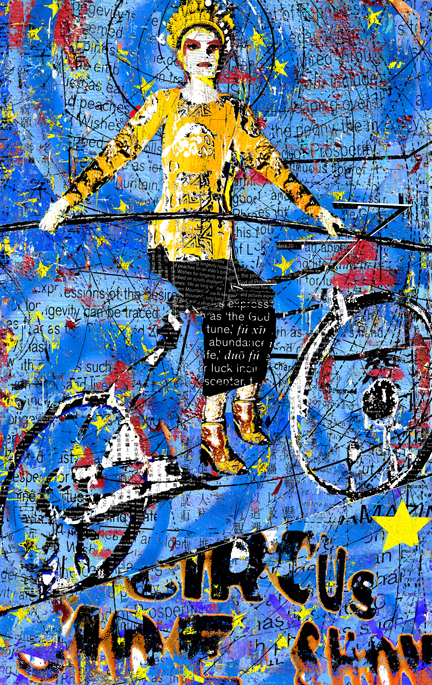
Balancing Act, 36″ x 62″, inkjet on aluminum, 2014
I am frequently asked two questions. The first is, “How long does it take you to do one of these?” The second is almost always in the form of a statement: “I’ll bet you have a lot of fun doing these.”
Neither answer is simple. To the “how long” question, the answer is “around 40 hours.” This is just an average, and doesn’t take into consideration the time I spend taking all of the photographs, or the times that I trash an image I’ve spent many hours working on because it’s not going anywhere. Then there’s the issue of my obsessive indecisiveness, whereby I declare something finished only to return to it the next morning to find that the piece spoiled during the night and needs more work.
Balancing Act, included with this post, is a case in point. Its true name should be Balancing Act #10 or #12. This is because I “finished” it a few months ago, so quickly that I was amazed and pleased it did not take the usual 40 or more hours. I then posted it, only to realize it still had significant issues. So I began working on it again until it was truly “finished.” This “finishing” and reworking went on so long I finally decided that the piece (and I) needed time to breathe. I recently returned to Balancing Act with an open and positive attitude, and I’m happy to say that it is really, finally finished…again….for now.
Why, you might be asking, was Balancing Act such a struggle to “finish?” I’d say it has something to do with the lack of balance that I felt this winter. So to end the longest rambling answer to a simple question, my pieces often take more hours than I can justify, for reasons that have everything to do with the intersection of life and art.
Here’s hoping we all have a balanced spring.

This is my series on our struggle and our interaction with the world and our inner reaction to it
Here is a link to the Museum Website. http://www.memphis.edu/amum/darylthetford.php
This is my series on our struggle and our interaction with the world and our inner reaction to it
Here is a link to the Museum Website. http://www.memphis.edu/amum/darylthetford.php

This 4 person exhibition opened January 17th, 2014 and will run through March 8th, 2014. The show was curated by Jeanne Shoaff who selected 12 pieces from my The Struggle to Evolve Before the End of Time series. Several of these pieces will also be on display beginning March 28th at the Art Museum at the University of Memphis Caseworks Gallery.
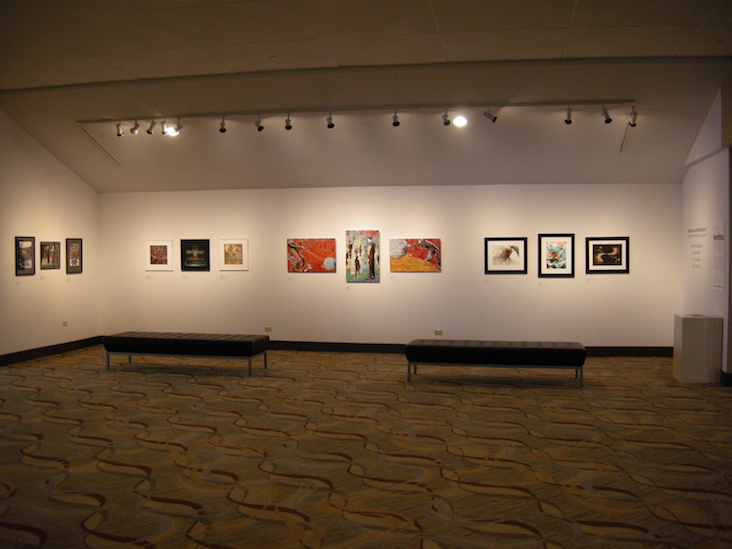
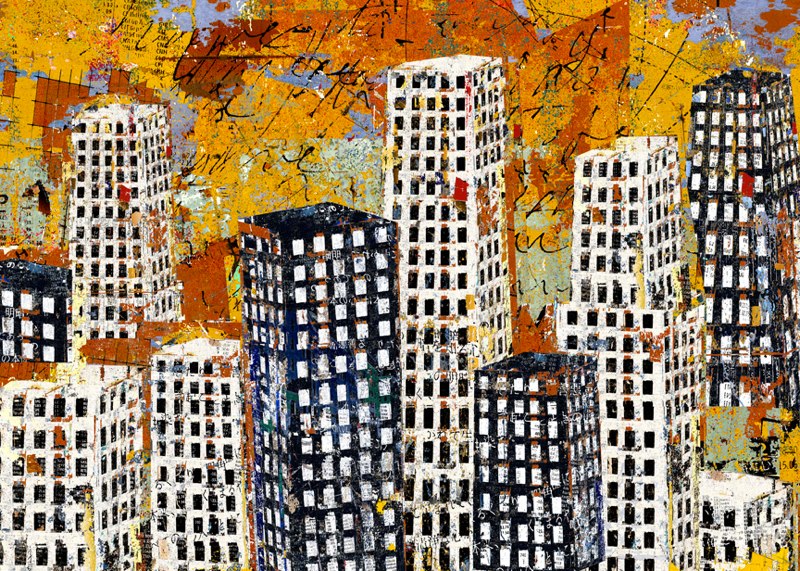
Brownstein, Hyatt, Faber and Schreck recently purchased two pieces for their offices in Denver.
I would like to thank Kay Brouillette and Chris Fullerton at Sapiro Art Consultants for their work on this project.
You can find more about them and see some of their work at this website. http://www.sapiroart.com/

I was recently sitting around thinking about food and lists. I had thought it would be fun to list some my favorite restaurants of 2013. The list is extensive and diverse, ranging from a vegan asian place in Providence, RI to the first place on my list in Tampa, FL.
I have since rethought the list idea, but since I am heading to St Petersburg, FL again for the Temple Beth-el Art fundraiser, I realize that I am excited not just about returning to the show ( which I am ) but also about returning to two of my favorite restaurants in the area.
I was in Tampa running an errand before the show began last year and decided to “google” the best places to eat Cuban food in the area. Two restaurants in the Ybor City section of Tampa came to the top of the search as one might expect. One of the top three, however really grabbed my attention. It was La Teresita Grocery. ( Columbus Ave at Lincoln in Tampa).
In La Teresita Grocery, a huge buffet of Cuban food is on display. For $5.00 I was able choose a meat, ranging from goat to chicken and 2 sides. So, the huge quantity and amazing fresh quality of chicken, black beans, rice and plantains cost me $5.00. I know I mentioned the price before, but is bears repeating. It would have still been a bargain at $12. I sat a a long community table and had one of the best meals of the year.
coln ) . http://www.yelp.com/biz/la-teresita-grocery-tampa?nb=1
The second place in the region is the Taco Bus on Central Avenue in St Petersburg, FL. I was browsing the antique shops and other interesting places along Central Avenue when I came upon a large line of people ordering food. While I assume that the bus is indeed mobile when they want it to be, a large indoor/outdoor seating infrastructure has built up around it making it an great place to eat and people watch. The menu is large and diverse and the food is fantastic. http://www.taco-bus.com/
See you in Florida.
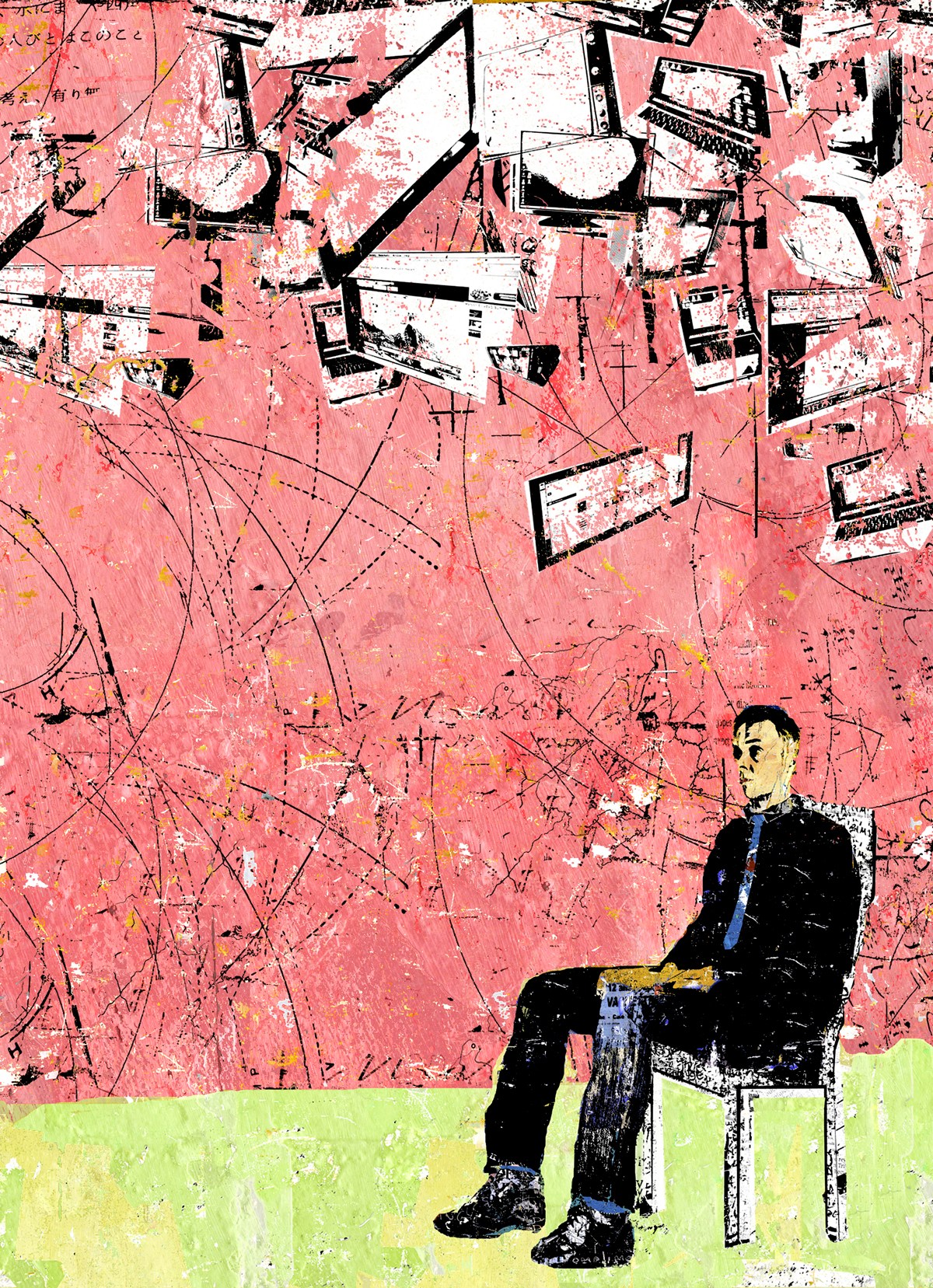
Man and Media II ( pictured ) is one of twelve images that I have at the Lincoln Center in Fort Collins, Colorado for the REFLECTIONS and RESOLUTIONS exhibit. All twelve of my pieces included are are part of the “Struggle for Evolution Before the End of Time” series.
The three other artists who “share the new worlds they’ve imagined through the media of Digital Art” are Fran Forman, Osvaldo Buccafusca and Daniel Fonken.
The show will run from opening night on January 17, 2014 to March 8, 2014.
Thank to curator Jeanne Shoaff for bringing the show together.

A few years ago, during a drive to Miami, I listened to 13 hours straight of Eckhart Tolle being interviewed by Oprah. During the course of these ( free ) podcasts, I got it. I saw what the eastern sages were talking about as a window, albeit a small one, opened up and reveled the universal truth of oneness to me. The lifestyle article for the Chattanooga Times Free Press about my experience, included below, was written by my wife Dana Shavin. She was the person who had not been in a car for 13 hours listening these podcasts, so her view of the events might differ from those who were enlightened..
Living in the Now Makes Problems Later
By Dana Shavin
My husband said something the other day that I should have found disturbing but didn’t. Which, frankly, disturbs me.
“That week we were so sick was the most fun I had all winter,” he said.
I knew what he meant. We never take time off from work to do nothing. We never even take time off to do SOMETHING. We just don’t take time off.
Case in point: Today is Sunday, and I am in my half of the studio, writing. I can hear my husband in his half of the studio rifling papers, printing things, pounding computer keys. I can assure you he isn’t surfing the net for pleasure or leafing through a magazine for fun. He’s working on new art images, contacting contacts, answering business e-mail, in short, creating, or following up on, opportunities.
Any minute now he’ll head over to my half of the studio to tell me everything he’s done. At which time I will be forced to ask him to leave, because I am busy creating my own kind of opportunity: I am getting some writing done so that I can then get some other writing done so that I can then get some research done so that I can then get some errands done.
Which is precisely why a week or so of body-flattening illness, during which we did nothing but lie on opposing sofas and talk, watch “Oprah” and obsessively take our temperatures was like a little dream vacation. Sad but true.
After our illness, I returned to business as usual. My husband, on the other hand, set off on an epic journey down the road to self-enlightenment. This is because he actually learned something from our downtime, which is that unremitting, achievement-oriented striving that takes you out of yourself and deposits you firmly in a mythical future where all that’s left is to appreciate the money and accolades you’ve garnered is a big fat waste of human time. He had already read “The Power of Now” and “A New Earth,” both by Eckhart Tolle. (Tolle, the king of the Now, is a spiritual anomaly who, by his own report, once spent two years sitting on a park bench doing nothing but smiling.)
It is a well-known fact that the road to spiritual enlightenment begins with a single download. What my husband discovered when he went looking, however, was not one but 10 90-minute conversations between Oprah Winfrey and Eckhart Tolle, which addressed not just the nebulous idea of living in the moment, but the nuts and bolts of how to actually stay present in a world replete with the stresses of family, work, health and domestic and international strife.
These downloads he listened to all the way to a Miami art show: 14 hours of pep talks, how-tos and earnest entreaties to forsake the What Might Be in exchange for the What Actually Is.
The next day, every nerve singing a song in praise of the Now, my husband discovered an irresistible photo-op: a shop window full of Buddha statues, with an old bench out front for passers-by to sit on. The bench, it turned out, was actually a rare antique, and the woman flying out of the front door of the shop was the bench’s owner who, upon seeing my husband settle his 200-pound frame into it, exchanged whatever serenity she had been enjoying in the moment for something akin to a blinding rage.
But by the time she got to him, he was already sauntering away toward the Miami Art Museum, to see at last the famed Robert Rauschenberg retrospective he’d been thinking about for weeks. Except that when he got there, he realized it wasn’t a Robert Rauschenberg retrospective but a Susan Rothenberg retrospective, a painter he neither knew nor cared anything about.
We were laughing about all this the other morning on our way to Birmingham to deliver art. It was a long day that included a stop at a hardware store, a frame shop, a restaurant and a shoe store. It wasn’t until the following day that my husband realized he’d walked all over Birmingham wearing one dark brown dress shoe and one tan casual shoe.
So while I know I should be living in the present, I am in fact worried about the future.
Given what’s already happening to my husband, can two years on a park bench with no goals and a kooky grin be far off?
Dana Shavin’s website is DanaShavin.com.

I am currently working on a 4 part commission.
I posted these two a few weeks ago before completion. Both have changed quite a bit since those first posts. One, much more than the other.
The image on the right hardly resembles the one posted on November 25th.
2 down and 2 to go.

I took this photo of a storm on the plains between Des Moines, Iowa and Denver. I used it as part template and part guide to create the collage ” Storm ” for my new landscape series. As you can see, I had to add the utility poles. I had photographed them on the same trip, just different location.
Gusto’s Pizza in Des Moines has the 66″ x 44″ version in their beautiful new place.